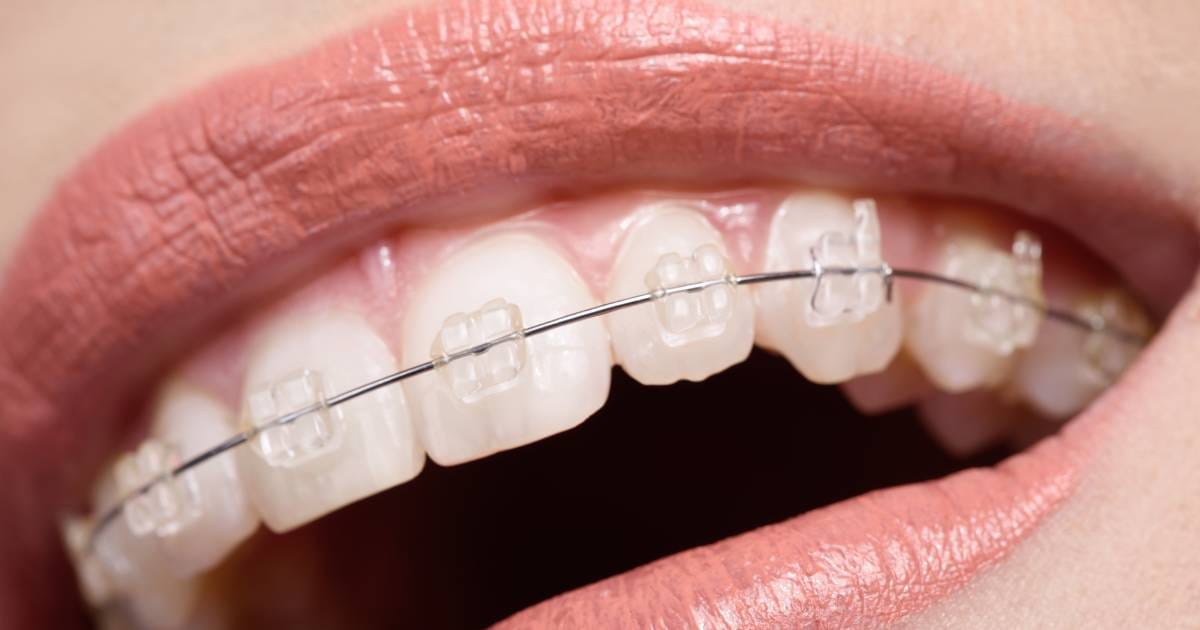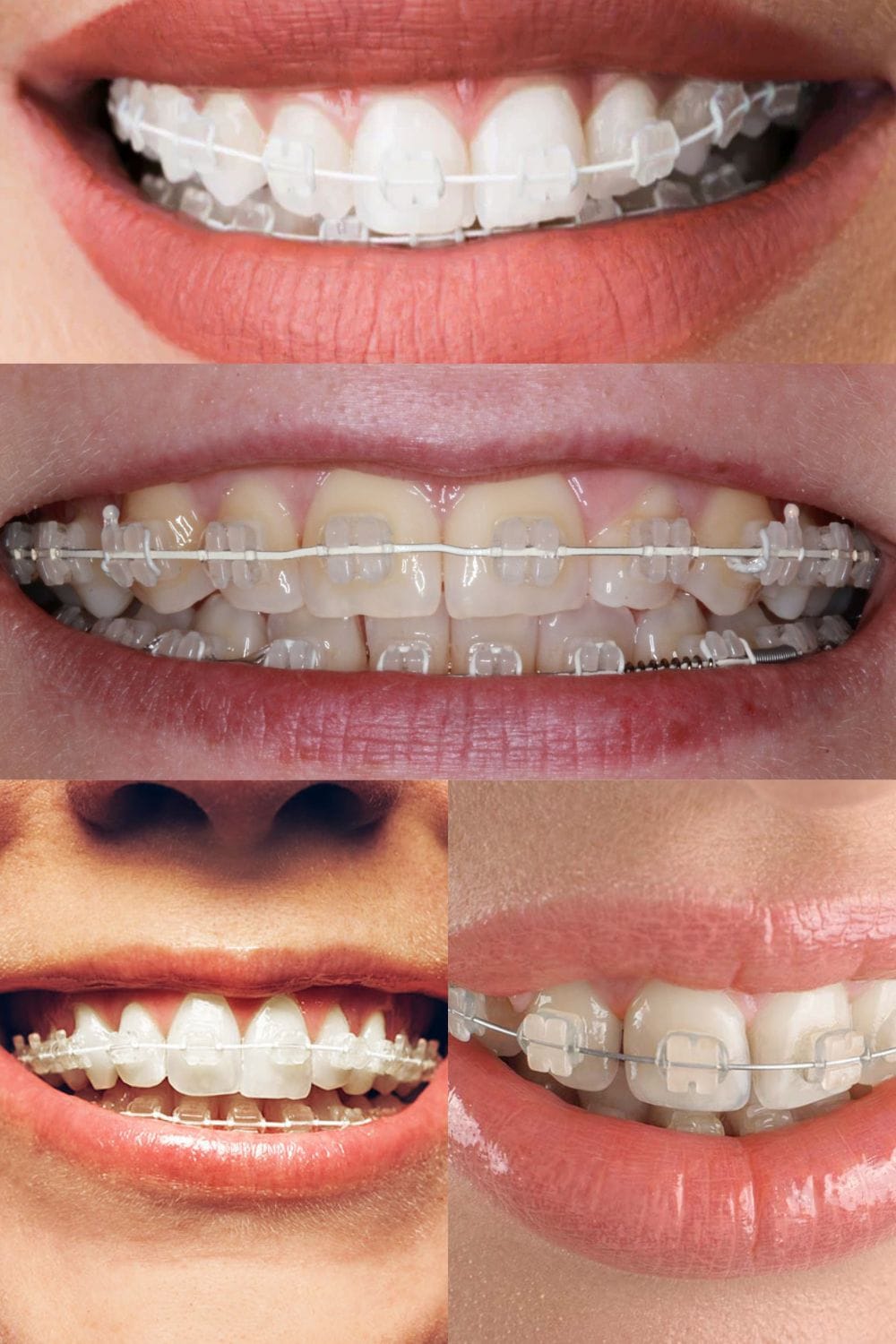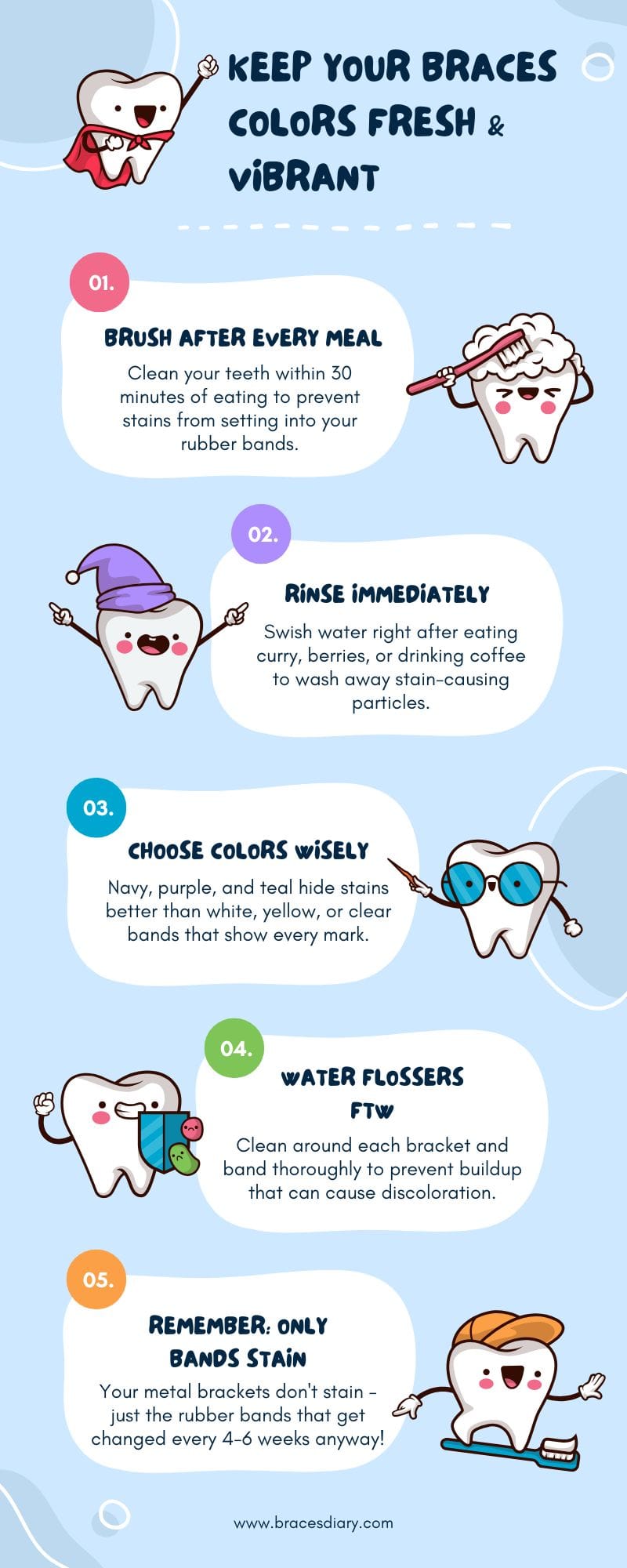White Braces: Staining Risks & Care Guide

The idea of white braces can be incredibly appealing – a vision of a super bright, clean, and crisp smile.
If you're aiming for a minimalist look or want your braces to make your teeth appear as white as possible, white elastics might seem like the obvious choice.
But before you jump on the white braces bandwagon, it's crucial to understand the realities that come with this color choice.
This guide will give you the unfiltered truth about white elastics: the major challenges with staining, how they can actually affect the appearance of your tooth color, and what you really need to know before making this high-maintenance decision.

The White Braces Dream vs. The Staining Reality
The number one dream for choosing white elastics is achieving a dazzlingly white smile. The number one reality? White elastics stain. A lot. And fast.
- Why the Staining Struggle is Real: White elastics, like other colors, are typically made from a porous polyurethane material. This means they readily absorb pigments from everything you eat and drink. Because they start as pure white, any discoloration is immediately and very noticeably apparent.
- The Top Offenders – Foods & Drinks That Wreak Havoc on White:
- Dark Beverages: Coffee, black tea, red wine (even if not a daily drink, one instance can stain!), dark colas, colored fruit juices.
- Intensely Colored Foods: Curry (turmeric is public enemy #1 for white elastics), mustard, tomato-based sauces (spaghetti sauce, ketchup), soy sauce, berries (blueberries, raspberries, etc.), beets.
- Vibrant Spices: Turmeric, paprika, saffron will turn white elastics yellow or orange in a heartbeat.
- Smoking/Vaping: Will quickly lead to yellowing and dinginess.
- Some Colored Mouthwashes: Brightly colored mouthwashes could potentially tint white elastics over time.
Related: Clear Braces Guide
Can White Braces Make Teeth Look Less White?
This is a critical point that many don't consider: unless your natural teeth are already exceptionally, paper-white (which is rare for most people), stark white elastics can actually create an unflattering contrast.
- The Contrast Issue: If your white elastics are significantly brighter white than your natural tooth enamel, they can inadvertently make your teeth look dull, dingy, or even more yellow by comparison. The super-white elastic becomes the reference point, highlighting any natural ivory or off-white tones in your teeth.
- When Stains Set In: Once those white elastics inevitably start to stain and turn an off-white, beige, or yellowish hue, they can then make your entire smile appear discolored, even if your teeth themselves are clean.
Key Takeaway: White elastics are a high-maintenance choice with a significant risk of staining quickly and potentially making your natural tooth color appear less vibrant.
White Braces Survival Strategies (If You're Determined)
If, despite the warnings, you're set on trying white elastics (perhaps for a very short period or a specific photo opportunity), here are some tips to try and manage the situation. Success is not guaranteed.
- World-Class Oral Hygiene – No Excuses:
- Brush Immediately After EVERYTHING You Eat or Drink (Except Water): This is not an exaggeration. The instant food or drink touches the elastics, the staining process can begin. Carry a travel hygiene kit everywhere.
- Floss Meticulously & Use Interdental Brushes: Any plaque or food debris left behind will contribute to a dingy look.
- Adopt a "White Diet" (Especially Initially):
- For the first few days or week after getting fresh white elastics, try to stick to light-colored or clear foods and drinks: water, milk, clear sodas (sparingly!), plain chicken, white fish, rice, potatoes, cauliflower, white bread, etc. This is highly restrictive and not sustainable long-term.
- Use a Straw for All Drinks (Except Water): Try to bypass your front teeth and elastics as much as possible.
- Avoid Known Staining Agents Like the Plague: Seriously, that list above? Treat it as gospel if you want your white elastics to last even a few days looking decent.
- Consider Them for Very Short-Term Wear Only: If you have an important event and want that initial bright white look, perhaps get them put on just before, knowing they likely won't stay pristine for long. Discuss this possibility with your orthodontist.
Related: Silver & Gray Braces Guide

Are There Any Scenarios Where White Braces Work Well?
Honestly, they are challenging for almost everyone. The ideal candidate for white elastics would be someone with:
- Naturally very, very white teeth (whiter than the elastics themselves, which is rare).
- An extremely disciplined approach to immediate post-meal hygiene.
- A diet that already avoids most common staining foods and drinks.
- A willingness to have their elastics changed more frequently if staining becomes unbearable (which may or may not be possible or practical depending on your ortho schedule).
White Braces vs. Other Subtle Options: Clear & Silver
If your goal is a discreet braces look, white isn't your only option.
Recommendation: For a low-key look with far less stress about staining, silver elastics are often the best practical choice, especially with metal brackets. Clear elastics are also very discreet but come with their own significant staining challenges (though perhaps slightly less rapid or stark than pure white).
Styling White Braces (If You Choose Them)
If you opt for white, aim for a clean, fresh, and bright overall style:
- Bright Clothing: Wearing white or bright, clear colors can complement the idea of a white smile.
- Minimalist Makeup: A fresh, natural makeup look often pairs best.
- Confidence: If you're dealing with the upkeep, own the look!
The Orthodontic Journey: Costs and Care with White Elastics
The process of orthodontic treatment remains the same, but your daily habits will need to be extra diligent with white.
- Oral Care with White Elastics:
- Hyper-Vigilance: As stressed throughout, immediate and thorough cleaning after consuming anything other than water is paramount.
- Gentle Products: Use a soft-bristled toothbrush and non-abrasive toothpaste.
- The Orthodontic Process & Costs:
- Initial Consultation & Treatment Plan: Your orthodontic journey will begin with an initial consultation. During this visit (which can often range from $50 to $250, though some practices may offer it free), your orthodontist will assess your needs, discuss your goals, and take necessary records like X-rays and photos. Based on this, they will develop a personalized treatment plan, outlining the type of braces recommended, the estimated duration of treatment, and the total associated costs.
- Full Treatment Costs: For comprehensive traditional metal braces treatment in the USA, the cost generally ranges from $3,000 to $7,500. This figure can vary significantly depending on factors such as the complexity of your orthodontic issues, the length of time you'll need to wear braces, the specific types of appliances used, and the geographic location of the orthodontic practice.
- Getting Braces & Regular Adjustments: The fee for the initial placement of your braces and all your subsequent regular adjustment appointments (which typically occur every 4 to 10 weeks, according to your specific treatment schedule) is included in the total treatment cost quoted in your plan.
- Elastic Color Changes (White Included, If Offered): Choosing white elastics, or any other standard color, from the selection your orthodontist provides is almost always included as part of your routine adjustment visits. There is generally no separate or additional charge for these standard fashion elastic choices. The "cost" of white elastics is primarily in the high maintenance and potential for a less-than-ideal aesthetic due to staining.
- Emergency Visits: Should you have an unexpected issue, like a broken bracket or a poking wire that requires an unscheduled visit, there might be a fee for this emergency appointment, often ranging from approximately $75 to $200 or more.
- Insurance Considerations: Many dental insurance plans include some level of orthodontic benefits. This often means the insurance company will cover a certain percentage of the treatment cost, up to a specified lifetime maximum. It is very important to thoroughly review your individual insurance policy to understand the specifics of your coverage.
White Braces: A Very Carefully Considered Choice
White elastics hold the promise of a bright, clean smile, but the reality of rapid and noticeable staining, coupled with the potential to make natural tooth shades appear duller, makes them a very high-maintenance and often aesthetically challenging option.
If your heart is set on the whitest possible look, achieving very white teeth through excellent oral hygiene and, if appropriate and recommended by your dentist after braces, professional whitening, will make a far bigger impact than white elastics.
For a subtle braces look during treatment, silver or even clear elastics (with understood cautions) are generally more practical and forgiving choices.
Before you request white elastics, have a very frank discussion with your orthodontist about the pros and (many) cons.
Pin this article as a reminder of what to expect! Make an informed decision for a braces journey that leaves you smiling brightly, not stressing over stains.





